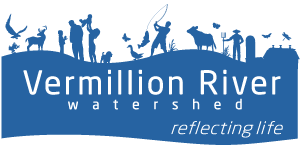Vermillion River watershed tour spotlights rural, urban conservation
From the Minnesota Board of Water and Soil Resources (BWSR) October 2023 Snapshots publication
During an eight-stop tour of projects across Dakota County, the Minnesota Board of Water and Soil Resources (BWSR) and the Vermillion River Watershed Joint Powers Organization (VRWJPO) highlighted local conservation and water-quality efforts throughout the Vermillion River watershed.
The tour drew more than 60 people who viewed and learned about local conservation and water-quality projects. Featured work included habitat enhancements, stormwater improvements, a 120-acre wetland bank easement, and a family farm that incorporated native prairie strips to filter surface water runoff.
BWSR and the VRWJPO hosted the daylong tour, which explored diverse projects in both urban and rural settings. The Vermillion River watershed covers 335 square miles, the largest by area in the seven-county metropolitan area.
About 49 miles of streams and tributaries in the watershed are Minnesota Department of Natural Resources- designated trout streams.
“There were a lot of urban opportunities to see projects and programs that we don’t always see and hear about as much,” said BWSR Board Chair Todd Holman.
“I thought the tour was an exceptional mix of urban, rural, private landowner work, collaboration with partners and local governments,” Holman said. “It showed in-stream habitat work, riparian habitat work, and all the thinking that goes behind each project. It showed how partners team together to use BWSR programs to help execute their goals and objectives.”
The tour drew representatives from the cities of Apple Valley, Farmington and Lakeville; landowners; Dakota County Soil & Water Conservation District staff; Dakota County commissioners and staff; and state and federal agency staff.
From its headwaters near Elko, the Vermillion River flows east through Dakota County to Hastings, where it falls over a bedrock cliff, creating Vermillion Falls. The river then turns south and runs parallel to the Mississippi River. The Cannon River joins the Vermillion before it discharges to the Mississippi River near Red Wing.
Recent assessments indicate challenges within the watershed include excess sediment, bacteria and nutrients, and low dissolved oxygen levels. These issues negatively impact wildlife, including trout. Additional watershed concerns include rising nitrate levels in groundwater and surface water.
The first tour stop, in the city of Lakeville, showcased habitat improvement efforts at East Lake, which is impaired due to excess nutrients. Adjacent woodlands contain a large population of invasive species within the understory. A habitat assessment the city completed in 2021 identified the need to continue restoration efforts within East Lake and the surrounding area. Since then, the city has partnered with the VRWJPO to restore 1,600 feet of shoreline and enhance 18 acres of native oak savanna. The Clean Water Fund-backed project included native seed plantings to stabilize the soil, plus invasive species removal on the shoreline and in the woodlands.
The next stop highlighted a stormwater reuse system in Lakeville’s King Park. Project partners — the city, the VRWJPO, BWSR and Dakota County — worked on a three-phase irrigation system to prevent stormwater runoff from overfilling the nearby stormwater pond and draining into Middle Creek, an impaired tributary of the Vermillion River.
In 2011, partners installed a pump system to irrigate two baseball fields and lower the water level in the stormwater pond. During the project’s second phase in 2016, a larger pond was built to collect stormwater from a nearby reconstructed road. A new, larger pump station was installed, and two additional baseball fields were irrigated. Lakeville spearheaded the third and final phase in 2019, which irrigated an additional four baseball fields and the park’s common areas using water from the pond.
Holman remarked on project partners’ ability to create a mutually beneficial system, despite their varying priorities.
“It’s not completely an easy process,” Holman said. “Those folks clearly worked together to try to figure out how to do good reuse and climate resiliency work, and cost-effective work for their constituents within the context of being safe, effective and thinking a little out of the box.”
Annual estimates show the first two phases of the project save about 3.1 million gallons of the municipal water supply. The project has seen other benefits including a reduction in total suspended solids, total phosphorous, E. coli and stormwater discharge into Middle Creek.
The tour concluded with a visit to the South Branch Vermillion River nitrate treatment constructed wetland in Castle Rock Township. The South Branch Vermillion River subwatershed has the highest nitrate load in the Vermillion River watershed, contributing to drinking water contamination in the eastern part of the watershed.
In 2017, the VRWJPO designed and constructed a nitrate treatment practice next to Dakota County Road 78, which the county was rebuilding. A wetland was created and enhanced with wood chips to reduce nitrate levels and improve the quality of surface and drinking water.
A neighboring pre-treatment pond allows the bulk of the sediment to settle out before water discharges to the wetland. The project reduces total nitrate levels by an estimated 13,600 pounds per year, and suspended solids by an estimated 7.6 tons per year. Additional benefits include improved habitat within the South Branch tributary and the main stem of the Vermillion River, where sediment negatively impacts wildlife refuge and spawning areas.


